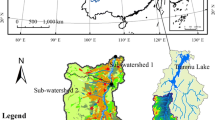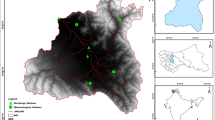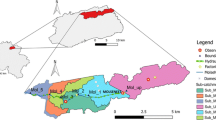Abstract
Numerous parameters are used to construct the HSPF (Hydrological Simulation Program Fortran) model, which results in significant difficulty in calibrating the model. Parameter sensitivity analysis is an efficient method to identify important model parameters. Through this method, a model’s calibration process can be simplified on the basis of understanding the model’s structure. This study investigated the sensitivity of the flow and nutrient parameters of HSPF using the DSA (differential sensitivity analysis) method in the Xitiaoxi watershed, China. The results showed that flow was mostly affected by parameters related to groundwater and evapotranspiration, including DEEPFR (fraction of groundwater inflow to deep recharge), LZETP (lower-zone evapotranspiration parameter), and AGWRC (base groundwater recession), and most of the sensitive parameters had negative and nonlinear effects on flow. Additionally, nutrient components were commonly affected by parameters from land processes, including MON-SQOLIM (monthly values limiting storage of water quality in overland flow), MON-ACCUM (monthly values of accumulation), MON-IFLW-CONC (monthly concentration of water quality in interflow), and MON-GRND-CONC (monthly concentration of water quality in active groundwater). Besides, parameters from river systems, KATM20 (unit oxidation rate of total ammonia at 20 °C) had a negative and almost linear effect on ammonia concentration and MALGR (maximal unit algal growth rate for phytoplankton) had a negative and nonlinear effect on ammonia and orthophosphate concentrations. After calibrating these sensitive parameters, our model performed well for simulating flow and nutrient outputs, with R 2 and ENS (Nash–Sutcliffe efficiency) both greater than 0.75 for flow and greater than 0.5 for nutrient components. This study is expected to serve as a valuable complement to the documentation of the HSPF model to help users identify key parameters and provide a reference for performing sensitivity analyses on other models.







Similar content being viewed by others
References
Akter A, Babel MS (2012) Hydrological modeling of the Mun River basin in Thailand. J Hydrol 452:232–246
Albek M, Ogutveren UB, Albek E (2004) Hydrological modeling of Seydi Suyu watershed (Turkey) with HSPF. J Hydrol 285:260–271
Arnold JG, Srinivasan R, Muttiah RS, Williams JR (1998) Large area hydrologic modeling and assessment part I: model development. J Am Water Resour Assoc 34:73–89
Bicknell BR, Imhoff JC, Kittle JL Jr, Jobes T, Donigian A Jr, Johanson R (2001) Hydrological simulation program-Fortran: HSPF version 12 user’s manual. AQUA TERRA Consultants, Mountain View
Borah DK, Bera M (2004) Watershed-scale hydrologic and nonpoint-source pollution models: review of applications. Trans ASAE 47:789–803
Chahor Y, Casali J, Gimenez R, Bingner RL, Campo MA, Goni M (2014) Evaluation of the AnnAGNPS model for predicting runoff and sediment yield in a small Mediterranean agricultural watershed in Navarre (Spain). Agric Water Manag 134:24–37
Crawford NH, Linsley RK (1966) Digital Simulation in Hydrology'Stanford Watershed Model 4
Diaz-Ramirez JN, McAnally WH, Martin JL (2012) Sensitivity of simulating hydrologic processes to gauge and radar rainfall data in subtropical coastal catchments. Water Resour Manag 26:3515–3538
Doherty J, Johnston JM (2003) Methodologies for calibration and predictive analysis of a watershed model. J Am Water Resour Assoc 39:251–265
Donigan AS, Imhoff JC, Bicknell BR, Kittle JL (1984) Application guide for hydrological simulation program: FORTRAN(HSPF). EPA-600/3-84-065 June 1984 Environmental Research Laboratory, Athens, GA 177 p, 19 fig, 17 tab, 3 app, 20 ref 68-01-6207
Donigian A (2002) Watershed model calibration and validation: the HSPF experience. Proc Water Environ Fed 2002:44–73
El-Kaddah DN, Carey AE (2004) Water quality modeling of the Cahaba River, Alabama. Environ Geol 45(3):323–338
Fonseca A, Ames DP, Yang P, Botelho C, Boaventura R, Vilar V (2014a) Watershed model parameter estimation and uncertainty in data-limited environments. Environ Model Softw 51:84–93
Fonseca A, Botelho C, Boaventura RAR, Vilar VJP (2014b) Integrated hydrological and water quality model for river management: a case study on Lena River. Sci Total Environ 485–486:474–489
Gallagher M, Doherty J (2007) Parameter estimation and uncertainty analysis for a watershed model. Environ Model Softw 22:1000–1020
Helton AM et al (2011) Thinking outside the channel: modeling nitrogen cycling in networked river ecosystems. Front Ecol Environ 9:229–238
Huo S-C, Lo S-L, Chiu C-H, Chiueh P-T, Yang C-S (2015) Assessing a fuzzy model and HSPF to supplement rainfall data for nonpoint source water quality in the Feitsui reservoir watershed. Environ Model Softw 72:110–116
Im S, Brannan KM, Mostaghimi S (2003) Simulating hydrologic and water quality impacts in an urbanizing watershed. J Am Water Resour Assoc 39:1465–1479
Lahlou M, Shoemaker L, Choudhury S, Elmer R, Hu A (1998) Better Assessment Science Integrating Point and Nonpoint Sources (BASINS), version 2.0. Users manual. Tetra Tech, Inc., Fairfax, VA (United States); EarthInfo, Inc., Boulder, CO (United States); Environmental Protection Agency, Standards and Applied Science Div., Washington, DC (United States),
Lenhart T, Eckhardt K, Fohrer N, Frede H-G (2002) Comparison of two different approaches of sensitivity analysis. Phys Chem Earth, Parts A/B/C 27(9–10):645–654
Li Z et al (2015) Simulation of runoff and nutrient export from a typical small watershed in China using the Hydrological Simulation Program–Fortran. Environ Sci Pollut Res 22:7954–7966
Liu Z, Tong STY (2011) Using HSPF to model the hydrologic and water quality impacts of riparian land-use change in a small watershed. J Environ Inform 17:1–14
Luo C, Li Z, Li H, Chen X (2015) Evaluation of the AnnAGNPS model for predicting runoff and nutrient export in a typical small watershed in the hilly region of Taihu Lake. Int J Environ Res Public Health 12:10955–10973
Migliaccio KW, Srivastava P (2007) Hydrologic components of watershed-scale models. Trans ASABE 50:1695–1703
Mishra A, Kar S, Singh VP (2007) Determination of runoff and sediment yield from a small watershed in sub-humid subtropics using the HSPF model. Hydrol Process 21:3035–3045
Mishra A, Kar S, Raghuwanshi NS (2009) Modeling nonpoint source pollutant losses from a small watershed using HSPF model. J Environ Eng-Asce 135:92–100
Muleta MK, Nicklow JW (2005) Sensitivity and uncertainty analysis coupled with automatic calibration for a distributed watershed model. J Hydrol 306:127–145
Nasr A, Bruen M, Jordan P, Moles R, Kiely G, Byrne P (2007) A comparison of SWAT, HSPF and SHETRAN/GOPC for modelling phosphorus export from three catchments in Ireland. Water Res 41:1065–1073
Patil A, Deng Z, Malone RF (2013) Temporal scale-induced uncertainty in load duration curves for instream-dissolved oxygen. Environ Monit Assess 185:1939–1949
Ranatunga T, Tong STY, Yang YJ (2017) An approach to measure parameter sensitivity in watershed hydrological modelling. Hydrol Sci J 62:76–92. doi:10.1080/02626667.2016.1174335
Ribarova I, Ninov P, Cooper D (2008) Modeling nutrient pollution during a first flood event using HSPF software: Iskar River case study, Bulgaria. Ecol Model 211:241–246
Singh J, Knapp HV, Arnold JG, Demissie M (2005) Hydrological modeling of the iroquois river watershed using HSPF and SWAT. J Am Water Resour Assoc 41:343–360
Taguas EV, Yuan Y, Bingner RL, Gomez JA (2012) Modeling the contribution of ephemeral gully erosion under different soil managements: a case study in an olive orchard microcatchment using the AnnAGNPS model. Catena 98:1–16
Tong ST, Liu AJ (2006) Modelling the hydrologic effects of land-use and climate changes. Int J Risk Assess Manag 6:344–368
Vörösmarty CJ et al (2010) Global threats to human water security and river biodiversity. Nature 467:555–561
Woodward G et al (2012) Continental-scale effects of nutrient pollution on stream ecosystem functioning. Science 336:1438–1440
Xia J, Zhang Y-Y, Zhan C, Ye AZ (2011) Water quality management in China: the case of the Huai River Basin. Int J Water Resour Dev 27:167–180
Xie H, Lian Y (2013) Uncertainty-based evaluation and comparison of SWAT and HSPF applications to the Illinois River Basin. J Hydrol 481:119–131
Zhang J, Ross M (2012) Hydrologic simulation of clay-settling areas in the phosphate mining district, Florida. Hydrol Process 26:3770–3778
Acknowledgements
The authors gratefully acknowledge the financial support by the National Natural Sciences Foundation of China (41571171), the Fundamental Research Funds for the Central Universities (KYZ201522), and the Priority Academic Program Development of Jiangsu Higher Education Institutions (PAPD).
Author information
Authors and Affiliations
Corresponding author
Additional information
Responsible editor: Marcus Schulz
Rights and permissions
About this article
Cite this article
Luo, C., Li, Z., Wu, M. et al. Comprehensive study on parameter sensitivity for flow and nutrient modeling in the Hydrological Simulation Program Fortran model. Environ Sci Pollut Res 24, 20982–20994 (2017). https://doi.org/10.1007/s11356-017-9741-7
Received:
Accepted:
Published:
Issue Date:
DOI: https://doi.org/10.1007/s11356-017-9741-7




